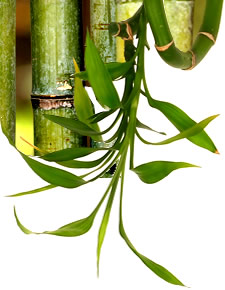

Thinning and Harvesting Bamboos |
One thing about growing bamboo: you never have a shortage of plant stakes. If you want your stand of medium-to-large bamboo to thrive, you will have to do some thinning anyway. Bamboo culms reach their peak as timber after the second growing season, and the culms of most species lose vigor and start to die after three or four years. Thinning removes the worn-out culms and lets light into the center of the clump to encourage new culms. The best method of thinning is to select culms at least two years old and harvest them by cutting them close to the ground with a pruning saw. Open up the stand to encourage new culms all through the clump rather than just around the periphery. Then trim the branches off the harvested culms and and set the culms aside to dry into poles. If you want to use the bamboo in craft projects or as building material, keep in mind that it is much easier to work green; do any shaping or bending before it dries. While mature stands often branch for just the top one-third of the culm, younger plants tend to have branches right down to the ground, giving your bamboo a shrubby look. For appearance's sake you may want to trim off the lower branches; the easiest way is to cut out the bud at each node as it begins to swell. Doing so will give you smooth bamboo poles without branch stubs. Use a sharp knife to remove the bud callus as it begins to thicken. Another option is to clip off the branches with pruning shears. If you use the poles as supports for beans or other climbing plants, the branch stubs offer a hold for the tendrils. |
© Copyright yayixm.com All rights reserved. Unauthorized duplication in part or whole strictly prohibited by international copyright law. |
|
|